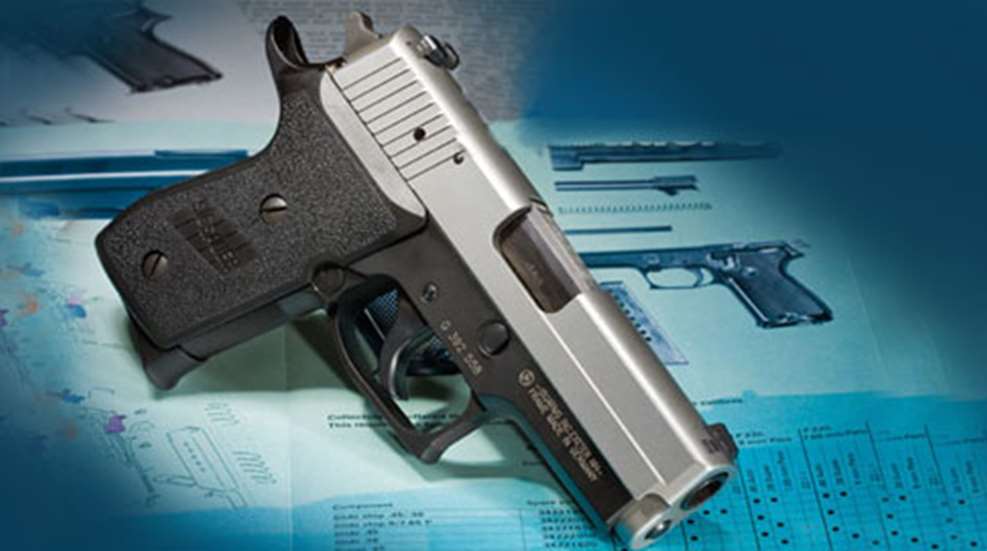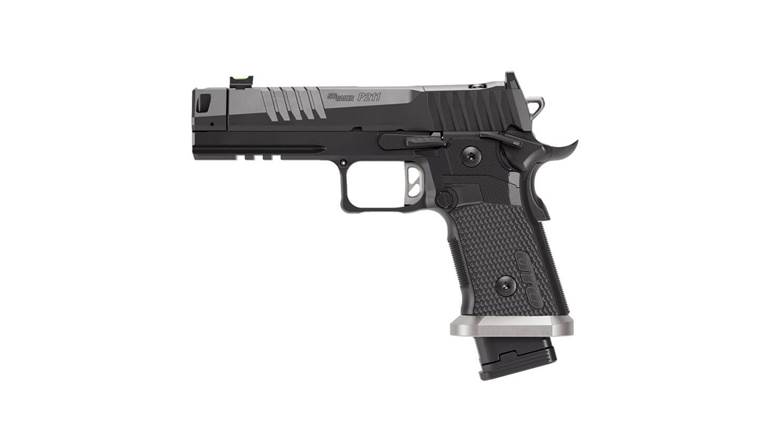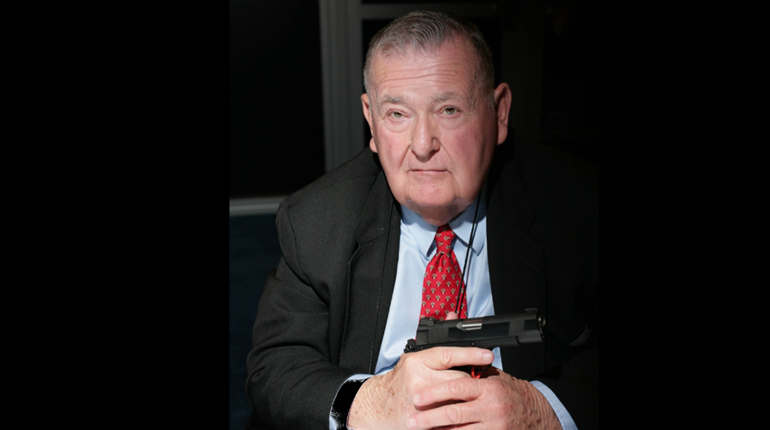
The semi-automatic pistol scene in the early 1970s was a lot different than it is today. There were fewer producers, and they didn’t offer as many variations. There were no polymer-frame guns, and the choices in trigger systems were few. You could choose a single-action gun, like the Colt and Browning, or a variation of the Walther-inspired double-action/single-action.
But the German police were in the market for a new service 9 mm Luger handgun, and that started some mighty clever minds to turning. Eventually, the German police pistol trials produced the Walther P5 and the Heckler & Koch P7, but the gun in the middle was the SIG Sauer P6, a size variation on the Swiss/German consortium’s P220. The other two pistols are almost forgotten, but the P220 is still here, and it has changed relatively little in the 35 years since introduced. One might conclude that they got it right the first time. They did—and the P220 has become a familiar friend to handgunners nationwide.
The P220 was a single-column, recoil-operated semi-automatic pistol with a first-shot double-action and subsequent-shot single-action trigger system. Imported and sold by Hawes and Interarms in the early ’70s, it was also offered by Browning as the BDA for a time. Eventually, SIG Sauer established a U.S. company in Herdon, Va., for the purpose of selling its own pistols, before moving to its present location in Exeter, N.H., in 1985.
The first P220s were built in 7.65 and 9 mm Parabellum, with small numbers added in .38 Super. When the gun came to America, .45 ACP was added to suit Yankee tastes. Today, P220s are only available in .45 ACP. Other calibers are in the extensive SIG catalog, but in different models. The first P220s reflected European tastes in other ways (such as the magazine catch location), but they had a host of innovations by anybody’s criteria. Mechanically, the gun was different in that it used a multi-piece slide formed from heavy sheet steel and fitted with a separate pinned-in breechblock. This feature made it easier to finish the gun in any caliber. Another significant innovation was the use of the ejection port as a locking point for the barrel. P220 barrels have a squared hood. Cams on the barrel’s underside work against a steel block in the aluminum receiver to index the barrel hood into the ejection port when the slide closes in battery. This feature has been copied all over the world.
However, it was an operational feature that distinguished the pistol in the wildly expanding marketplace of the ’70s and ’80s. The P220 had (and still has on most variations) a first-shot DA trigger pull. When the hammer is down in the carry mode, trigger pressure through an arc will raise the hammer to the fully ready position and then release it to fire. On firing, the slide cycles the hammer to the fully cocked position and the next trigger pull is a short and crisp single action. If the shooter needs to stop shooting, he can safely decock the hammer with a quick, downward press of the decocking lever. The point is simply that the P220 doesn’t have, and doesn’t need, a manual safety mixed into the functions of this lever. That is not the case with most of the P220’s contemporaries.
The P220 caught on big time, particularly in the law enforcement sector. With such a simple operating system, police instructors found the gun rather easy to teach, although the DA-to-SA transition was tough for some people to master. When other calibers became popular—9 mm, .40 S&W and .357 SIG—the company modified the basic pistol system to accept high-capacity magazines in these calibers and gave them different designations—P226, P228 and P229. Over the many years the P220 has been imported, there have been numerous small changes to the gun. One of the most welcome was one of the earliest—a late ’80s moving of the heel-mounted magazine catch to a more desirable spot aft of the trigger guard. In the past few years, the upgrades and modifications have come thick and fast, adding up to a major expansion of the P220 lineup. The current SIG Sauer catalog shows 16 .45 ACP P220 variations. By the time you add in finish and lockwork options, the number of variations has doubled. All of them are the same basic pistol, but SIG Sauer has responded to the desires of its customers by providing options in the size and finish of the gun, as well as the manner in which it is handled and fired—the lockwork.
The four sample pistols display all of the new options except finish. Also, there are two variations of the Elite P220 series that have stainless steel frames. All of the other models are made with aluminum alloy frames. Further, all of the current P220 slides are machined stainless forgings—yesteryear’s stamped slides and pinned-in breechblocks are no longer used. The majority of models have the original double-action/single-action trigger system that permits safe, hammer-down carry and a first shot double-action trigger pull. It is sometimes called a “decocker, no-safety” system. But SIG now offers two options to this original trigger system—a pure single-action (or SAO, for single-action-only) and the DAK (for double-action, Kellerman). This latter option is a form of double-action-only, in which the trigger must be swept through a long arc for each shot. Going first to a standard size gun, we find the typical P220 with 4.4" barrel and slide made of matte-finished stainless steel. Most commonly, this variation will be encountered with the original DA/SA lockwork, but my sample came with the SAO system. This gives the shooter a single-action trigger, complete with frame-mounted, down-to-fire ambidextrous safety. There is no decocking lever since the gun is intended to be managed in the manner of the Hi-Power or M1911. I noticed that the slide can be racked with the thumb safety up. For some situations, this is a very worthwhile feature. The trigger pull was very good, breaking with a small amount of creep at just under 6 lbs. As a veteran SIG shooter, I found much about this gun to be familiar; the SAO trigger would take time to fully master.
The next gun was a beauty—the P220 Match. On this one, the trigger system was the old familiar DA/SA. Naturally the gun is also available with the new SAO trigger, which might be a better idea if the shooter was using the gun in competition. SIG Sauer equips the P220 Match with a new and beautifully crafted rear sight. It is a fully click-adjustable (windage and elevation) sight that is mounted very low in the slide by means of a sturdy dovetail. It’s obvious that serious design effort went into beveling the sides of the sight for use in speed-oriented action games. At the same time, the sight’s rear face presents a precise sight picture. The P220 Match is about 3 ozs. heavier than the standard P220, and all of the extra weight is out front at the muzzle. That’s because the company made the Match gun with a 5” barrel and slide. This gives the pistol a muzzle-heavy heft. It also tends to dampen the recoil thrust a little bit. The Match version is a good-looking gun that handles even better. If you are after a greater level of performance, there is also a Super Match variant. If SIG added a half-inch of slide and barrel to the standard P220 to produce the Match, removing a like amount might have a good effect for other reasons. It absolutely does, and the resulting gun is called the P220 Carry. The Carry is the marriage of a shortened 3.9" barrel and the standard receiver. Intended for use in concealed carry roles, the Carry gun is easier than the standard gun to manipulate from under a coat or loose shirt. For a defensive carry gun, the sample’s trigger system is just about perfect. It is a DAK. A form of DAO, the DAK trigger fires with a 7-lb., double-action sweep of the trigger for every shot. The hammer cannot be cocked in the conventional sense, and is therefore neither a safety nor a decocker. Shooters who use the DAK system often fall in love with it. My experience with the system is limited, but it seems obvious that learning where the trigger reset point is located, then also learning to allow the trigger to go to that point and not beyond, is the key to proper DAK shooting. People who study police shootings and really delve into tactical training are aware that a second gun has saved the life of more than one police officer. The same is true of civilian encounters. Second guns need to be small and so do concealed carry pistols in general. The P220 Compact is as small as they can make a P220 .45. Using the same 3.9" barrel and slide upper as the P220 Carry keeps the length concealable. On my sample Compact, the trigger system goes back to the P220’s roots. It’s the old familiar DA/SA that helped earn SIG’s current strong position in the marketplace. The butt shortening resulted in a pretty limited handle to grip, but SIG recognized the problem and put a finger extension on the forward end of the magazine floorplate.
These four P220 pistols pretty well summarize a nicely varied line of modern .45s. There are four size variations, three lockwork choices and a number of finish options. Certain models are done up with handsome wooden grips and other cosmetic enhancements in the company’s custom shop. The Elite series is not represented here. They are upgraded standard-size P220s, all with a distinguishing feature of the beavertail grip tang. Before I did the tabulated accuracy evaluation, I fired all of the guns for general function and suitability for their roles. No malfunctions of any kind cropped up, and the only adverse comment I could make was that magazines are sometimes a little difficult to load.
I had no more than fired the first two or three five-shot groups with the first gun in the Ransom Rest than I began to suspect that it was going to be a pretty good shoot. I used three different commercial loads that have turned in impressive performance in the past. They were Hornady’s 200-gr. JHP/XTP, Remington’s 230-gr. Bonded Golden Saber JHP and Black Hills 230-gr. JHP (featuring Speer’s Gold Dot bullet). With three loads, firing five, consecutive five-shot groups from each of the four pistols, I was at the range for a while. Accuracy results were more than impressive.
There were groups as small as 0.47" and only one went over 3", but the majority were under 2". In a five-group average, a few sub one-inchers really pull the overall average down, and that is what happened here. By the time the averaging was all done, the overall P220 group size was 1.61". I suspect that the relatively tight chambers and exact barrel crowns may be a part of it, but in the final analysis the accuracy is good because the SIG P220s are just fine guns. Not having fired everything available in a similar shoot, I can’t objectively say these pistols are better than everything. But on the other hand, I don’t really know of any service-grade pistol that will consistently outshoot a P220.
Manufacturer: SIG Sauer; (603) 772-2302; sigsauer.com
Caliber: .45 ACP
Action Type: recoil-operated, center-fire, semi-automatic pistol
Frame: aluminum alloy
Slide: stainless steel
Barrel: 4.40"
Rifling: six-groove, 1:16" LH twist
Magazine: detachable box, eight rounds
Sights: post front with Tritium dot, twin dot rear
Trigger Pull: 5 lbs., SAO
Overall Length: 7.70"
Width: 1.50"
Height: 5.50"
Weight: 31.2 ozs.
Accessories: lockable hard case, lock, manual, spare magazine
Suggested Retail Price: $960




































